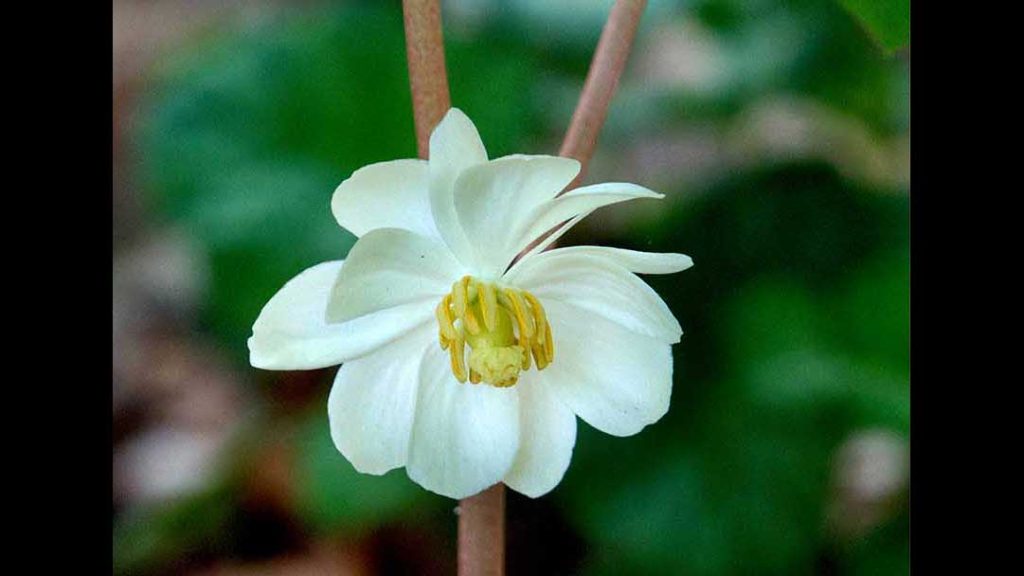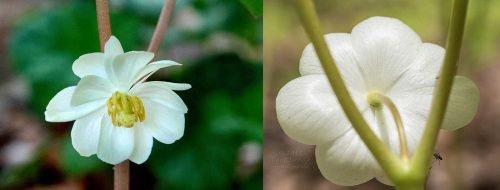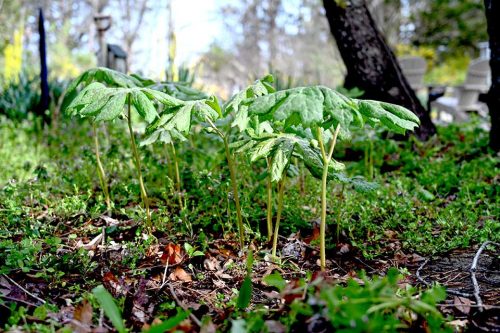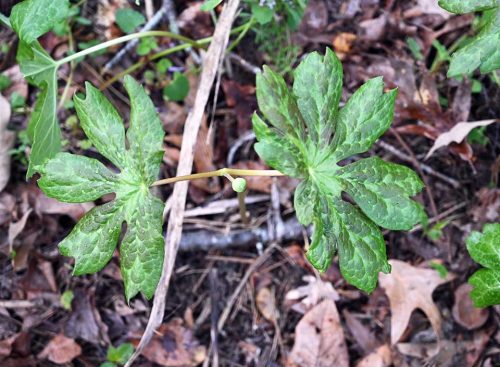Fleeting Flora
The mayapple is a spring ephemeral, so-called because it is short-lived, which makes spotting it in springtime gardens and woodlands that much more precious.


In 2018 CU Maurice River hosted a trip to Bowman’s Hill Wildflower Preserve, south of New Hope, Pennsylvania. The preserve is actually considered an outdoor museum for regional plants.
We were fortunate enough to have Mary Anne Borge, a naturalist, photographer, author, and educator, as our guide. She did a marvelous job. It was late April and we explored the spring ephemerals on the property. These are plants with a short life cycle lasting only a few days to a few weeks, and April and early May are great times to see them.
One of my favorite early arrivals in the garden is mayapple or Podophyllum peltatum, so named because it typically blooms around the beginning of May. Initially it pushes through the earth’s surface like a rounded, closed umbrella and then unfurls into a flat leaf. Young stems have a single stalk with one leaf and do not bud or flower. But second-year and older plants fork into two terminal branches, creating a Y with a leaf on top of each. In the center of the Y a single stalk with one waxy bud is attached. The bud will mature into a flower almost two inches across.
It can also be referred to as mandrake, wild lemon, and raccoon berry, although personally I have never heard it called by any name other than mayapple.

As of April 10, the ones in our garden have a number of flower buds. When the flower blooms it will be a bit showy—about two inches across. The flower matures into a sweet fruit that is yellow-green and said to be edible, but only when it is solid yellow.
Many of the plants do not survive into summer and thus it is considered ephemeral. On the few plants that persist the fruit matures in August. The immature fruit and other parts of the plants are poisonous to humans. However life is about timing; each plant that bears fruit produces only one and it must be ripe to be eaten, for only then is it safe. Nonetheless, forest creatures are likely to have beaten you to the meal. I’ve seen only a few fruits and I have looked often.
On the Bowman’s tour Mary asked us who the seed dispersers might be. One of our participants correctly guessed box turtles. Being a box-turtle-fancier my ears perked up when she mentioned this bit of information. Since then I have read that other animals, such as the white-footed mouse, gray squirrel, grackle, opossum, raccoon, fox, and black bear (Lobstein), may also disperse the seeds. And while the plant is not high in nectar resources, it produces a good amount of pollen. Queen bumblebees collect this for rearing workers, which likely results in some pollination as well.
The plant spreads primarily by rhizome growth, or underground stems that grow horizontally. In this fashion the mayapple makes new plants, sending up its one-foot stalks. Biologist Marion Lobstein of Northern Virginia Community College discusses the importance of rhizome growth, explaining that a seed doesn’t form a rhizome until five years of age and it may not produce blooms until 12 years of age. A colony, which may have as many as 1,000 shoots, expands four to six inches per year and some colonies are estimated to be more than 100 years old. Furthermore, if this plant does put out fruit, the following season it may produce only one stem and not the forked branch that bears the flower, fruit, and seed.
Each leaf has five to seven lobes that radiate from a central point, called a palmate. In a colony they make a light green carpet that looks like a parade of Mummers’ parasols frozen along their route.
Native Americans, especially the Delaware, Iroquois and Cherokee, valued the plant’s parts for medicinal purposes. Powdered roots were used for ulcers and sores. Root juice was applied in the ear for deafness. Roots were also prized for their laxative properties. The plant is mentioned in many sources as a cure for intestinal worms and warts, and as an insecticide for crops. Carter’s Little Liver Pills contained an extract from mayapple.
But before you consider experimentation, know that many sources also reported that Native Americans knew of the mayapple’s toxicity and used its roots and shoots to commit suicide. The U.S. Food and Drug Administration lists the plant as unsafe because of its powerful purgative properties. Synthetic formulations have been employed in modern-day medicines to fight lung cancer, testicular cancer, and warts.

The plant is found in humus-rich woods from Ontario south to Texas, and encompassing areas east to the Atlantic.
This time of year you have an opportunity to see many native ephemerals, such as Dutchman’s breeches, squirrel corn, bloodroot, trillium, bluebell, spring beauty, and twinleaf. You will also see emerging skunk cabbage and lots more flora. Permit me to recommend a visit to Bowman’s Hill Wildflower Preserve adjacent to the Delaware River and just south of New Hope proper, and arrange for a guide to enrich your experience. Call and inquire before making the trek (website: bhwp.org – telephone: 215-862-2924).
If you choose to go to the Bowman’s Hill Tower Overlook you can peer down upon the site of Washington’s Crossing. If you’re really ambitious, spend a morning at the Preserve and an afternoon at the Washington Crossing Historic Park on the New Jersey side. And if you venture out I would love to hear about your experience; e-mail me at [email protected]!
Sources
Wildflowers of Pennsylvania, M. Haywood, RSM, Ph.D., P. Monk, M.Ed. 2001.
“Mayapple,” Wild News May-June, Marion B. Lobstein, Botany Chair, Prince William Wildflower Society.
Bowman’s Hill Tour 2018.
Native American Ethnobotany, Daniel E. Moerman.








